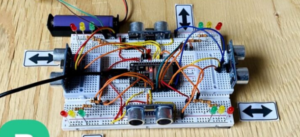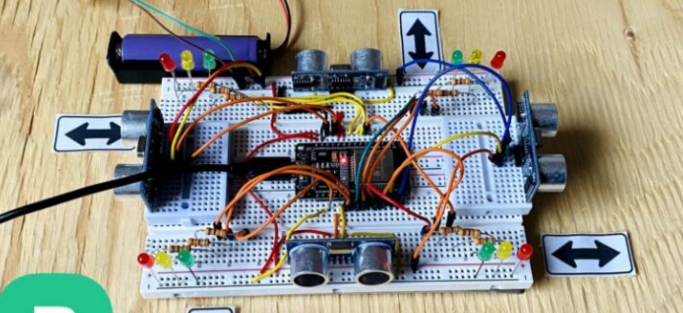Building a Smart Traffic Light System Using IoT: Revolutionizing Urban Traffic Management
With the rapid growth of urbanization, cities are facing increasing traffic congestion, leading to longer commute times, higher fuel consumption, and a rise in pollution levels. To address these challenges, smart traffic management systems have become essential. One of the most promising solutions is the implementation of Internet of Things (IoT) technology in traffic lights. A smart traffic light system that utilizes IoT can enhance traffic flow, reduce energy consumption, and improve road safety. This article explores how to build a smart traffic light system using IoT and its potential benefits for urban transportation.
What is a Smart Traffic Light System?
A smart traffic light system integrates sensors, real-time data analytics, and IoT technology to dynamically adjust traffic signal timings based on traffic flow and conditions. Unlike traditional traffic lights that follow fixed cycles, a smart system can respond to changing traffic patterns, allowing for more efficient management of roadways.
By utilizing data collected from connected devices such as cameras, sensors, and traffic monitoring systems, smart traffic lights can optimize signal timings, reduce wait times, and even prioritize emergency vehicles, improving overall traffic efficiency.
Key Components of a Smart Traffic Light System Using IoT
To build a smart traffic light system, several IoT components and technologies must be incorporated. These include sensors for real-time traffic monitoring, communication networks for data transmission, and data analytics platforms to process and respond to the information.
1. IoT Sensors and Cameras
The foundation of a smart traffic light system is the sensors and cameras that collect real-time data on traffic flow, vehicle count, and road conditions. Some commonly used sensors include:
- Inductive Loop Sensors: Installed under the road surface, these sensors detect the presence of vehicles by measuring changes in the magnetic field as a vehicle passes over.
- Infrared Sensors: These sensors detect vehicles by measuring heat signatures, allowing for accurate monitoring in various weather conditions.
- CCTV Cameras: Video cameras are used to monitor traffic and detect congestion or accidents, providing valuable data for the system to adjust the traffic light timings accordingly.
2. Traffic Control Unit (TCU)
The Traffic Control Unit (TCU) is the brain of the smart traffic light system. It processes the data collected from the sensors and uses algorithms to optimize traffic light timings. The TCU also communicates with the central system to provide real-time updates and alerts regarding traffic conditions or incidents.
- Adaptive Traffic Control Algorithms: These algorithms use machine learning and artificial intelligence to predict traffic patterns and adjust the lights in real time. They can also prioritize traffic based on factors like vehicle volume, time of day, or emergency vehicle requests.
3. Communication Networks
To facilitate communication between traffic lights, sensors, and the central management system, robust communication networks are required. These can include:
- Wireless Networks: Wi-Fi or cellular networks can connect traffic lights and sensors to the cloud for data processing and remote control.
- V2X Communication (Vehicle-to-Everything): V2X enables communication between vehicles and infrastructure, providing real-time information to both the smart traffic light system and drivers to improve traffic flow and safety.
4. Cloud-Based Data Analytics
Cloud-based platforms are crucial for processing the large volumes of data generated by the smart traffic system. These platforms use advanced data analytics, machine learning, and predictive modeling to analyze traffic patterns and make real-time decisions about traffic signal timing.
- Real-Time Traffic Analysis: The system analyzes data from sensors and cameras to identify congestion points, accidents, and high-traffic times. It then adjusts traffic signal timings to optimize traffic flow and reduce bottlenecks.
- Traffic Prediction and Forecasting: Using historical data, the system can forecast traffic conditions and proactively adjust signal timings to prevent congestion.
Steps to Build a Smart Traffic Light System Using IoT
Building a smart traffic light system involves several stages, from designing the hardware and software components to integrating the IoT infrastructure. Here are the key steps involved:
1. Planning and Requirements Analysis
The first step in building a smart traffic light system is to assess the traffic patterns, road infrastructure, and specific needs of the area. This involves:
- Identifying high-traffic intersections that would benefit most from smart traffic management.
- Analyzing historical traffic data to understand peak hours and traffic volume.
- Determining the necessary sensors, cameras, and communication networks for the area.
2. Setting Up IoT Sensors and Cameras
Once the planning phase is complete, the next step is to deploy the necessary IoT sensors and cameras at strategic locations around the intersection. These devices will collect real-time data on vehicle count, traffic flow, and road conditions. Installation should be done carefully to ensure accurate data collection and minimal disruption to traffic.
3. Building the Traffic Control Unit (TCU)
The Traffic Control Unit (TCU) is the core component that controls the operation of the traffic lights based on the input received from sensors and cameras. The TCU should be designed to communicate with the central system, process real-time data, and adjust signal timings accordingly.
- Custom Software Development: The software must include algorithms for traffic prediction, adaptive signal control, and integration with emergency response systems.
- AI and Machine Learning: The system should incorporate machine learning models to predict traffic congestion and optimize traffic flow.
4. Establishing Communication Networks
To ensure seamless communication between the traffic lights, sensors, and the central management system, a robust communication network must be established. This may involve setting up wireless communication protocols such as Wi-Fi, cellular, or V2X technologies to transmit data in real time.
5. Cloud Integration and Data Analytics
The collected data must be transmitted to the cloud for further analysis and processing. Cloud-based platforms use big data analytics and machine learning to derive actionable insights from the real-time traffic data. These insights are then used to optimize signal timings, manage traffic flows, and reduce congestion.
- Real-Time Monitoring: Operators can monitor traffic conditions remotely through a central dashboard, allowing them to make adjustments if necessary.
- Predictive Analytics: The system can predict future traffic conditions and adjust signal timings accordingly to prevent delays.
Benefits of a Smart Traffic Light System Using IoT
The implementation of IoT-based smart traffic lights offers numerous benefits for urban traffic management:
1. Improved Traffic Flow
By dynamically adjusting traffic signal timings based on real-time traffic data, smart traffic lights can reduce congestion and improve traffic flow. This results in shorter travel times and less time spent idling at traffic lights.
2. Reduced Fuel Consumption and Emissions
Optimized traffic signal timings reduce the amount of time vehicles spend idling at intersections, which in turn reduces fuel consumption and greenhouse gas emissions. This helps cities move towards greener, more sustainable transportation systems.
3. Enhanced Safety
Smart traffic lights can prioritize emergency vehicles and respond to accident alerts in real time. By adjusting traffic signals to clear the way for ambulances, fire trucks, or police vehicles, the system enhances public safety and ensures faster response times.
4. Cost Savings
While the initial investment in IoT-based traffic systems may be high, the long-term benefits include reduced maintenance costs, improved traffic efficiency, and lower fuel consumption. Additionally, the ability to optimize traffic flow can lead to fewer accidents and reduced infrastructure wear and tear.
Challenges in Implementing Smart Traffic Lights Using IoT
While the benefits are significant, there are several challenges that need to be addressed when implementing IoT-based smart traffic systems:
- High Initial Costs: The initial setup cost for IoT sensors, cameras, communication infrastructure, and software development can be significant.
- Data Security: With IoT devices transmitting large amounts of data, ensuring data privacy and security is crucial to prevent cyberattacks.
- Scalability: Expanding the system to cover larger areas or additional intersections may require significant upgrades to the infrastructure and software.
Conclusion: Smart Traffic Lights for Smarter Cities
Building a smart traffic light system using IoT technology is a powerful way to address the challenges of urban traffic congestion. By integrating sensors, cameras, real-time data analytics, and machine learning, cities can optimize traffic flow, reduce fuel consumption, and enhance public safety. Although the implementation may come with challenges, the long-term benefits of IoT-based smart traffic systems make them a crucial step towards building more efficient, sustainable, and smarter cities for the future.

Also Read :
